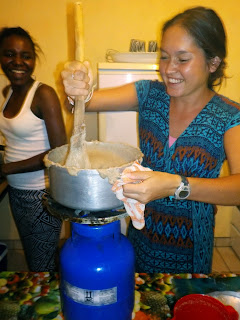I don’t know that I’ll ever be able to make one of those “10
things I learned in the Peace Corps” lists, but this is the closest I’ve come
so far:
I’ve been back in the US for about a month, and it’s one of
the hardest facts to understand. It’s wonderful to be home, and I miss my
Namibian life as well – but trying to compare the two is pretty much an apples
and oranges situation. Sometimes it even seems hard to remember how day-to-day
life was in Namibia; but then, sometimes it seems hard to comprehend why things
are as they are here in America.
Being back with family is one of the best parts!
This obsession with perfection is one of the things I have
always found hardest about American culture. It is so easily to slide into that
routine of expecting 150% (from everyone, about everything, always), and it’s
something I’ve been guilty of my whole life. It’s also something that exactly
opposes most cultures of the developing world. While I’m working at a summer
composed of kids who fly across oceans to learn algebra for a few weeks, my
learners in Namibia are just trying to maintain the 40% necessary to pass their
classes. They’re preparing for a beauty pageant and, you know, most of the time
they seem pretty ok with things. Although I would love for them to be pushed a
bit harder in school (for the career opportunities if nothing else), even after
3 years I find it difficult to understand why we seem to be trying so hard to
make them American kids. I was stressed as heck during high school, and I
definitely did more than I needed to—and I can’t necessarily say that
overbooking myself to the point of exhaustion really did anything for me in the
long run.
I guess I can’t say which is better. I really miss the pace
of life in Namibia, and the way you are really able to stop and enjoy whatever
it is you are doing. Then again, it’s hard to miss some of the sexism and
extreme conservatism that showed up on a daily basis. In the same way, the liberal
society and amenities in the US are great, but I’m not so convinced about our
personal belief systems. In the end, I have to say I think the most value came
from having the amazing opportunity to experience both, and to learn from mentors
and friends versed in both cultures.




























